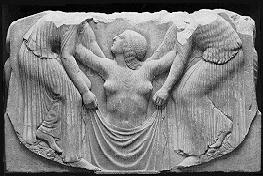 |
Persephone, simultaneously the goddess of the Underworld and regeneration, is usually shown in Greek Art being abducted by Hades, as in the Locrian Pinake shown left, or prosiding over the Underworld. There are very few representations of her return to earth in the spring. It is difficult to show that the Ludovisi Throne represents this myth, as the figures on the side panels would not relate. If the Ludovisi Throne does show the return of Persephone, it would again be linked with the cults of Locri, but it seems far more likely that it represents the birth of Aphrodite. |
| It has also been suggested that the Ludovisi Throne, right, venerates Hera, the goddess of marriage and childbirth, who was a mother to Eileithyia, which would link the action on the throne to that of childbirth. Hera was worshipped as a girl, bride and old woman, and it is possible that the throne shows her annual bathing in the spring Canathus at Temenium in Argos which renewed her virginity. However, Hera does not have regular attributes in Greek Art and can only be identified by specific context. At times it is impossible to distinguish her from Aphrodite, and as there are few contemporary illustrations of her annual renewal of virginity, it seems more likely that the Ludovisi Throne represents Aphrodite. |  |